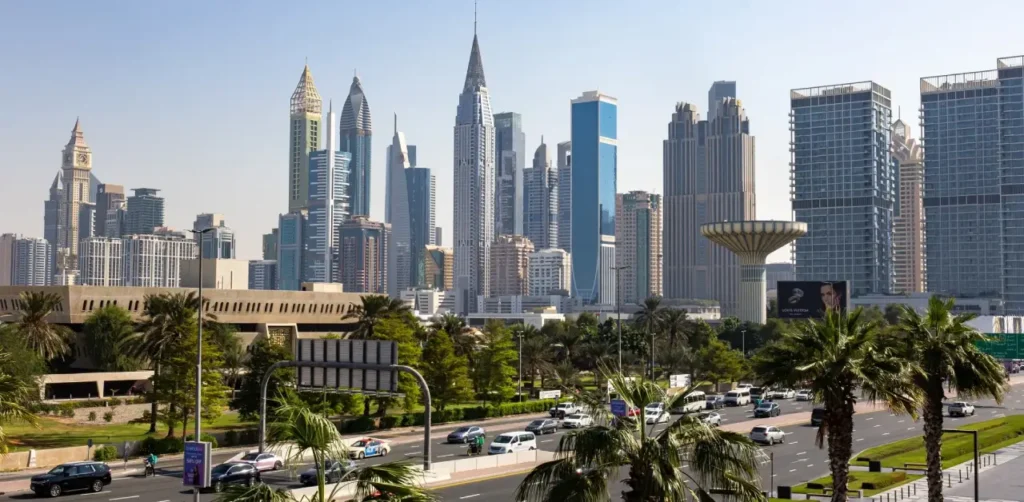Executive Brief: Dubai’s real estate market is unlikely to crash despite 300,000 new units launching by 2028. Population growth of 5% annually, tourism doubling to 40 million visitors, and strong investor demand will absorb most supply. Some suburban areas may experience temporary oversupply and minor price corrections of up to 15% by 2026-27, while prime locations remain strong and undersupplied.
If you’ve been following the global conversation on real estate, you’ve likely come across one recurring question: Is the Dubai property market heading for a crash in the next few years? Many analysts and social media commentators have been predicting a downturn in 2027, 2028, or 2029, citing the large number of new property launches and handovers in the pipeline.
At GenZone, we work closely with investors, developers, and end-users every single day. We’ve analyzed the numbers, and what we’ve found might surprise you: the Dubai real estate market is not on the verge of a massive oversupply-led crash. In fact, the data suggests quite the opposite—Dubai may remain undersupplied in key segments for years to come.
In this article, we’ll break down the real numbers behind supply, demand, population growth, tourism trends, and investor behavior. We’ll also highlight one area that could experience temporary oversupply and how that might impact prices.
Why Are People Expecting a Crash?
The idea of a crash largely stems from one key factor: supply projections. There are indeed thousands of units scheduled for handover in the coming years. To put this into perspective:
- In 2025, around 55,000 units are expected to be delivered.
- In 2026, this number rises to 65,000 units.
- In 2027, the biggest year in recent history, we anticipate about 109,000 units.
- In 2028, another 77,000 units are expected.
By the end of 2028, Dubai could see close to 300,000 new units entering the market. On the surface, this sounds like a recipe for oversupply and subsequent decline. It makes many people ask: “will Dubai real estate market crash?” However, this perspective ignores a very critical element i.e.. the growing demand.
Population Growth: The Engine of Demand
Dubai’s population growth story is nothing short of remarkable. Let’s look at the numbers:
- In 2024, the population stood at 3.8 million.
- By 2025, it increased to 3.95 million.
That’s an addition of 150,000 new residents in just one year. Many question whether this growth is sustainable and some wonder “will Dubai real estate crash?”, but if we analyze historical patterns and current trends, the answer is clear: population growth is accelerating, not slowing down.
Over the last 12 months, Dubai welcomed 140,000 new residents, and as more global businesses establish a presence here, that number could climb even higher. Historically, Dubai’s population grew at 3% annually, but now we are seeing growth rates closer to 5% annually. Some projections even suggest 6% to 10%, though we consider that overly optimistic for conservative forecasting.
Let’s stick with a 5% growth assumption for a realistic scenario:
- Current population: 3.95 million
- By 2028: 4.57 million
- Increase: 620,000 new residents
How Many Homes Will These New Residents Need?
On average, each housing unit in Dubai accommodates about 2.8 people. Using that ratio:
- 620,000 new residents ÷ 2.8 = approximately 220,000 new housing units needed
Now compare this with the 300,000 units coming to market by 2028. It seems like a surplus, but the calculation isn’t that simple. Those asking “is Dubai property market slowing down?” are definitely overlooking additional demand factors.

Other Demand Drivers Beyond Residents
Population growth is just one part of the equation. Dubai’s real estate market is also fueled by:
- Tourism: In 2024, Dubai welcomed 20 million tourists. By 2031, the target is 40 million annually. This doubling of visitors will require more short-term rental properties, serviced apartments, and holiday homes.
- Golden Visa Program: High-net-worth individuals are buying property to secure 10-year residency.
- Corporate Relocations: Over 700 multinational companies have set up in Dubai in recent years, bringing executives and staff who rent or buy premium homes.
- Investors Seeking Yield: Dubai still offers attractive rental yields compared to global cities, drawing investors from Europe, Asia, and beyond.
Factoring these in, demand is significantly higher than the base housing requirement for residents.
Year-by-Year Supply vs Demand Forecast
Let’s break it down:
- 2025:
- Demand: ~67,000 units
- Supply: 55,000 units
- Result: Shortage
- 2026:
- Demand: ~70,500 units
- Supply: 65,000 units
- Result: Shortage
- 2027:
- Demand: ~74,000 units
- Supply: 109,000 units
- Result: First temporary surplus (147% absorption rate)
- 2028:
- Demand: ~78,000 units
- Supply: 77,000 units
- Result: Balanced market
This shows that 2027 could see some short-term oversupply, but the market quickly corrects by 2028. Additionally, construction delays, investor-owned vacant units, and properties kept for personal use reduce effective supply.
Why “Oversupply” Is Not the Whole Story
Many assume that more supply automatically leads to lower prices. That’s not always true. The impact depends on:
- Location of new projects
- Quality and positioning of properties
- Developer reputation and project handover timelines
For example, Downtown, Business Bay, Dubai Marina, and Jumeirah have limited space for new developments. Supply here remains constrained, so prices in these areas are unlikely to drop significantly.

The One Area Likely to Face Oversupply: JVC
If there’s one area where we expect a temporary imbalance, it’s Jumeirah Village Circle (JVC).
- 13,900 new units are being delivered this year alone.
- In 2026, another 11,800 units are planned.
- The following years will add thousands more.
JVC has grown rapidly in recent years, evolving from an underdeveloped area to a well-established community with schools, malls, and parks. But the sheer number of new projects means rental prices and capital appreciation could flatten in the short term.
That said, even in JVC, opportunities remain if you buy at the right price per square foot and select quality developers.
Vacancy and Investor Behavior
A significant number of properties in Dubai are purchased as secondary homes or investment properties that remain unoccupied. Some investors prefer to hold rather than rent, which means effective supply is lower than official figures suggest.
Additionally, construction delays are common. If even 10% of the planned 300,000 units face delays, that’s 30,000 fewer units in the market, further tightening supply.
Tourism’s Role in Sustaining Demand
Dubai isn’t just a business hub. It’s the world’s top tourism destination. With 40 million annual visitors expected by 2031, demand for short-term rentals and branded residences will skyrocket. This trend will keep certain segments like luxury apartments and waterfront properties in high demand.
Our Conclusion: No Crash, Just Cycles
At GenZone, we believe the Dubai property market will experience micro-corrections in 2027 due to concentrated supply in specific areas like JVC, but overall, the market remains fundamentally strong.
Key reasons:
- Population growth continues at 4% to 5% annually.
- Tourism demand is doubling.
- Corporate migration and the Golden Visa program keep attracting investors.
- Even after accounting for all handovers, a net deficit of around 47,000 units remains by 2028.
So, is the market heading for a collapse? Absolutely not. If you’re a smart investor focusing on prime locations, high-demand communities, and quality projects, the next five years offer strong opportunities for capital appreciation and rental yield.
Looking to Invest?
At GenZone, we specialize in identifying the right projects in the right areas—whether it’s waterfront developments, branded residences, or high-demand communities with strong rental potential.
If you want expert guidance on Dubai real estate investment:
- Book a consultation with our team
- Explore projects offering strong ROI and Golden Visa eligibility
- Get market insights tailored to your investment goals
Frequently Asked Questions
What is the Dubai real estate market forecast for 2028-2030?
The Dubai real estate market forecast for 2028-2030 shows a positive and balanced outlook. Population growth, tourism expansion, and foreign investments are expected to sustain strong demand. While 2027 may witness a temporary oversupply, prices are most likely to remain stable or grow modestly in prime areas.
Will Dubai real estate market crash in the coming years?
Even though there are some concerns, real estate experts say a crash is unlikely. Temporary oversupply may occur in some segments, but high demand from residents, investors, and tourists should prevent an extensive market collapse.
Will Dubai real estate crash soon?
There may be some short-term corrections, which may affect areas with a huge spike in new projects. But as per analysis, Dubai’s prime areas, including strategic locations, high rental yields, and government regulations, reduce the chance of a significant crash.
Is Dubai real estate market slowing down?
As said above, some areas with the new surge in properties may undergo some corrections because of increased supply. But the overall Dubai property market is on the move. Many factors, including increasing demand, Golden Visa buyers, and growing business relocations, will likely keep the market intact.




